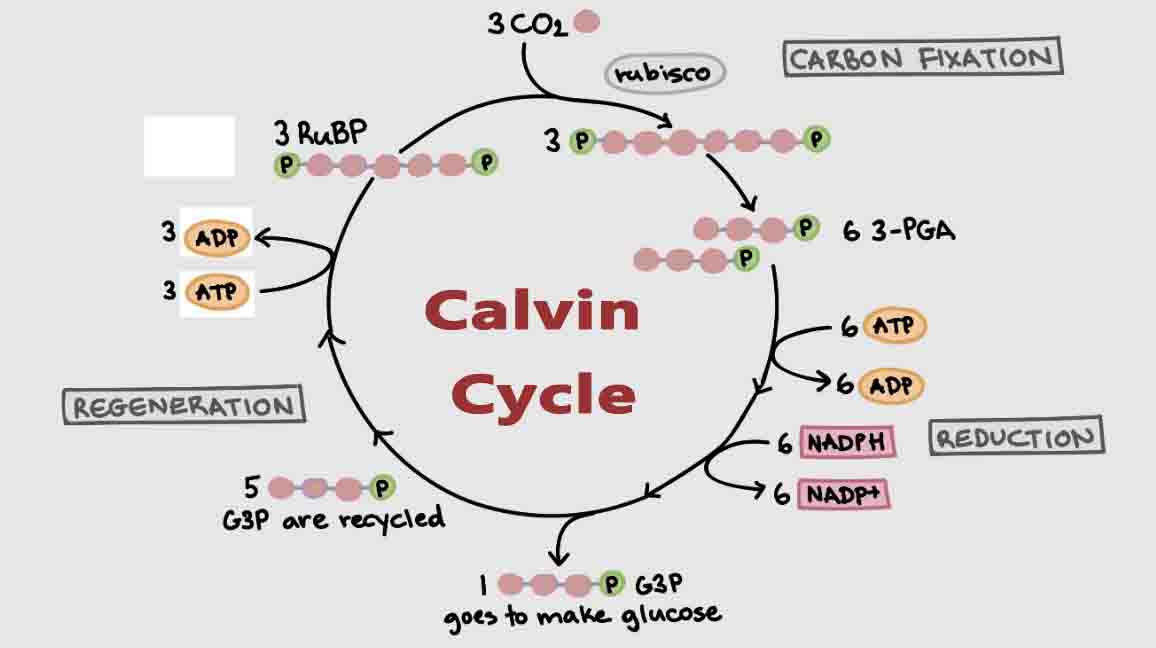Calvin Cycle Definition
In plants, the Calvin cycle involves chemical reactions that “fix” carbon from CO2 into three-carbon sugars.
The three-carbon compounds can later be converted into amino acids, nucleotides, and more complex sugars such as starches by plants and animals.
“Carbon fixation” is the process by which most new organic matter is created. Plants also store long-term energy from sugars produced in the Calvin cycle, as opposed to ATP, which is used up quickly.
Plant sugars can also provide energy to animals that eat plants and predators that eat herbivores.
Since the Calvin cycle is not directly powered by photons from the Sun, it is sometimes called the “light independent” reactions of photosynthesis. As a result of light-dependent reactions, ATP and NADPH are created, which power the Calvin cycle.
Function of the Calvin Cycle
Calvin cycles create three-carbon sugars, which are then used to build other sugars such as glucose, starch, and cellulose that plants use as structural materials. Plant matter is made from carbon molecules that are taken directly from the air by the Calvin cycle.
The Calvin cycle is therefore vital to the existence of most ecosystems, since plants form the base of the energy pyramid. In the absence of the Calvin cycle, plants would not be able to store energy in a form that herbivores could digest. Thus, herbivores would not be able to access the energy stored in their bodies!
As well as making proteins, nucleic acids, lipids, and all the other building blocks of life, plants and animals make carbon backbones in the Calvin cycle.
Additionally, the Calvin cycle regulates the levels of carbon dioxide in the atmosphere, a greenhouse gas. The burning of coal, oil, and gasoline has put enormous amounts of CO2 back into the atmosphere, but humans have also cut down about half of all Earth’s forests, which play an important role in removing CO2 from the atmosphere.
Calvin Cycle Steps
Carbon Fixation
A CO2 molecule from the atmosphere combines with a five-carbon acceptor molecule called ribulose-1,5-bisphosphate (RuBP).
A three-carbon compound, 3-phosphoglyceric acid (3-PGA), is formed from the six-carbon compound.
In this reaction, RuBP carboxylase/oxygenase, also known as RuBisCO, catalyzes the reaction. RuBisCo is probably the most abundant enzyme on Earth due to its role in photosynthesis.
Reduction
By the second stage of the Calvin cycle, the molecules of 3-PGA created through carbon fixation are converted into molecules of glyceraldehyde-3 phosphate (G3P).
In this stage, ATP and NADPH are produced as a result of light-dependent reactions during photosynthesis. As a result, plants convert sunlight into long-term storage molecules, such as sugar, through the Calvin cycle. ATP and NADPH transfer energy to sugars.
In this step, NADPH donates electrons to 3-phosphoglyceric acid molecules to create glyceraldehyde-3 phosphate. “Reduction” is the process of donating electrons, while “oxidation” is the process of taking electrons.
Regeneration
Glyceraldehyde-3 phosphate molecules go into the production of glucose, while others must be recycled to regenerate the five-carbon RuBP compound that accepts new carbon atoms.
In order to regenerate, ATP is required. There are many steps involved in this process.
To make a single molecule of glucose, six carbon molecules must be combined to form a glucose molecule.
Five out of six glyceraldehyde-3 phosphate molecules produced through the Calvin cycle are regenerated into RuBP molecules. As the sixth exits the cycle, it becomes half of a glucose molecule.
Calvin Cycle Products
By turning the Calvin cycle once, one molecule of carbon is fixed and can be used to make sugar.
Glyceraldehyde-3 phosphate can be produced by three turns of the Calvin cycle.
Glucose molecules can be made by combining two molecules of glyceraldehyde-3 phosphate after six turns of the Calvin cycle.
Calvin cycle turns also consume three ATP and two NADPH in reducing (adding electrons to) 3-phosphoglyceric acid to produce glyceraldehyde-3 phosphate and regenerating RuBP to accept a new atom of carbon from CO2.
In order to produce one molecule of glucose, 18 ATP and 12 NADPH are required.
Related Biology Terms
- Chloroplast – The organelle in plant cells where energy from sunlight is turned into ATP and sugar.
- Energy Pyramid – A diagram that illustrates the flow of energy through an ecosystem.
- Photosynthesis – The process by which living things capture energy from sunlight and use it to make fuel and organic materials to build their cells.

